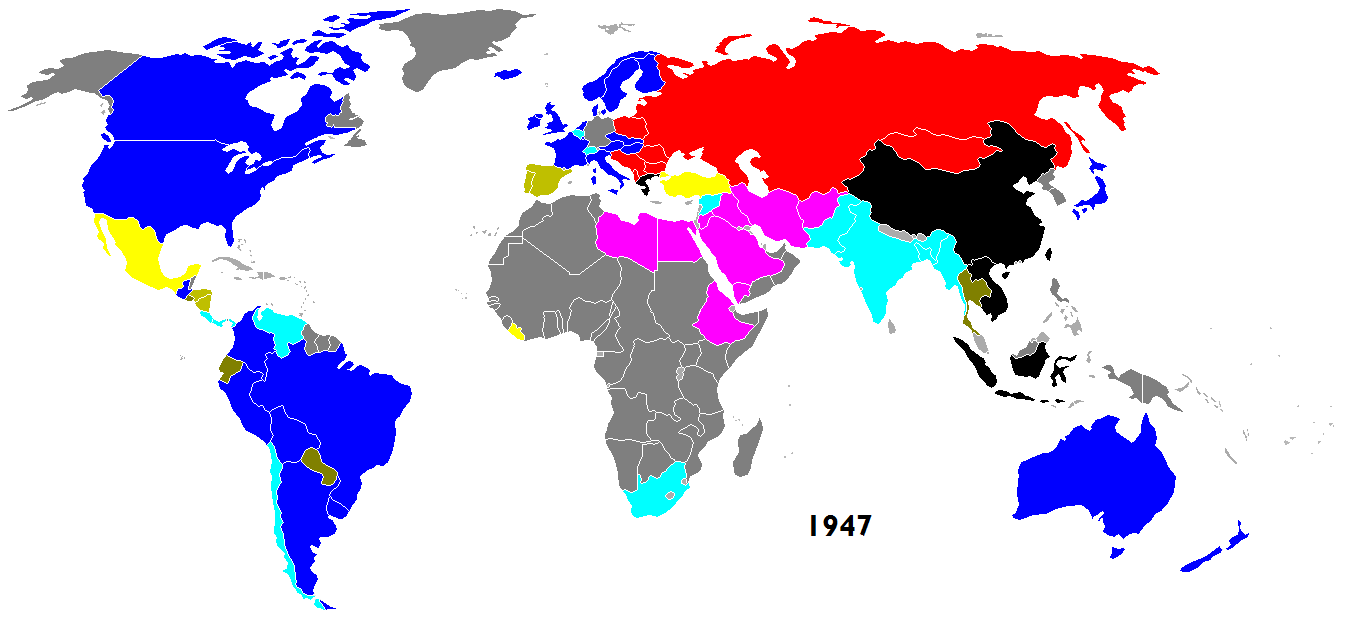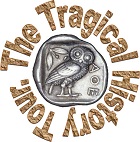
Chapter Twenty-five
The late 1940s
Colonial Independence
The Second World War had spread chaos throughout the colonies, especially in the Far East where the Japanese tried to take over the European empires for themselves. In the lag time between when the Japanese moved out and the Europeans moved back in, nationalist movements in the Dutch East Indies and French Indochina took advantage of the power vacuums to declare their independence. Even in places that had escaped direct warfare, colonial control was shaken. The winners of the Second World War had fought to preserve freedom worldwide, so they were now sort of expected to grant freedom to their own people or face charges of hypocrisy.
By 1950, nineteen new nations (more or less) had emerged, and colonialism was pretty much dead in Asia. The British released Ceylon (Sri Lanka nowadays) in 1948 and it became mostly democratic for the rest of its history. The Americans let the Philippines go in 1946 with a democratic government, but then, at the last minute, the United States tacked a few more conditions onto the deal which gave Americans multiple trade privileges and many military bases under long-term leases.
![Flag of India [Flag of India]](images/1947-Flag_of_India.png) The largest of the
new nations was India, where nearly one out of every
five humans lived. At the insistence of the Muslim
community under Jinnah, two Muslim majority regions were
split off, one in the west, along the Indus River and
border of Afghanistan, and the other in the east at the
mouth of the Ganges River in Bengal. Together, these
became the independent nation of Pakistan, while the
residual Hindu majority regions remained as India. The
split sparked a massive ethnic cleansing, during which a
half million or so people who ended up on the wrong side
of the new border were killed and 15 million expelled.
Mohandas Gandhi was among the murdered as he tried to
calm his people down and stop the violence.
The largest of the
new nations was India, where nearly one out of every
five humans lived. At the insistence of the Muslim
community under Jinnah, two Muslim majority regions were
split off, one in the west, along the Indus River and
border of Afghanistan, and the other in the east at the
mouth of the Ganges River in Bengal. Together, these
became the independent nation of Pakistan, while the
residual Hindu majority regions remained as India. The
split sparked a massive ethnic cleansing, during which a
half million or so people who ended up on the wrong side
of the new border were killed and 15 million expelled.
Mohandas Gandhi was among the murdered as he tried to
calm his people down and stop the violence.
The split also left the fate of the autonomous Himalayan Kingdom of Kashmir undecided. With a Muslim majority, it looked like it should go to Pakistan, but the Hindu monarch who had the final say in the matter decided to join India instead. The two countries got into an immediate war over the place, and Kashmir ended up split along the line where the armies stopped shooting at each other.
![Damascus, June 1957: President Shukri al-Quwatli and Prime Minister Jawaharlal Nehru of India at a State Banquet during Nehru's visit to Syria. [al-Quwatli and Nehru]](images/1956_President_Shukri_al-Quwatli_and_Indian_Prime_Minister_Jawaharlal_Nehru_-_June_1956.jpg) Jarwahal
Nehru became India’s first prime minister. More
conventionally political than Gandhi, Nehru was firmly
committed to democracy and active in party politics
during the colonial era. In the decade before
independence, he split with his colleague Bose, who felt
that Indian nationalists should use the Nazis and
Japanese to drive out the British. Nehru excelled at
networking and detail work. He also wore more clothes
than Gandhi, so mercifully we don’t have to see his
knees or nipples in history books; in fact his
distinctively Indian jacket became an inescapable
worldwide fashion fad for a couple of weeks in the late
1960s.
Jarwahal
Nehru became India’s first prime minister. More
conventionally political than Gandhi, Nehru was firmly
committed to democracy and active in party politics
during the colonial era. In the decade before
independence, he split with his colleague Bose, who felt
that Indian nationalists should use the Nazis and
Japanese to drive out the British. Nehru excelled at
networking and detail work. He also wore more clothes
than Gandhi, so mercifully we don’t have to see his
knees or nipples in history books; in fact his
distinctively Indian jacket became an inescapable
worldwide fashion fad for a couple of weeks in the late
1960s.
Nehru was clearly, recognizably leftist. Later, as president of India, he was straight socialist. Internationally, Nehru was widely criticized on the right for not being as hostile to Russia as the West wanted.
Syria
Meanwhile,
t![Flag of Syria [Flag of Syria]](images/1932-Flag_of_Syria.png) he French were
being difficult about their colonies after WW2. While
everyone else was letting go, the French fought long,
stubborn wars to keep Indochina and Algeria. Generally,
most of these wars don't fall neatly into a history of
democracy because by the time France finally lost its
wars and colonies, the natives were too heavily-armed
and bitter to settle quietly into representative
government. The nationalist rebels who beat the French
immediately set themselves up as the only legal party,
and anyone who didn’t like it was shot; however, Syria,
another French colony on its way out in the 1940s,
actually passed through a transitional democratic phase.
he French were
being difficult about their colonies after WW2. While
everyone else was letting go, the French fought long,
stubborn wars to keep Indochina and Algeria. Generally,
most of these wars don't fall neatly into a history of
democracy because by the time France finally lost its
wars and colonies, the natives were too heavily-armed
and bitter to settle quietly into representative
government. The nationalist rebels who beat the French
immediately set themselves up as the only legal party,
and anyone who didn’t like it was shot; however, Syria,
another French colony on its way out in the 1940s,
actually passed through a transitional democratic phase.
When Syrian nationalist Shukri al-Quwatli started his fight for freedom in 1913, the Ottoman Empire was his people's oppressor. The Ottoman Turks arrested and tortured al-Quwatli a couple of times until he finally slashed his wrists in jail to make the torture stop before he broke down and named names. He survived his cuts only because a fellow prisoner was a doctor and patched him up, just in time to see the Ottomans lose World War One and their empire. When word got out about al-Quwatli’s stubborn determination in jail, he became a national hero.
At first after the Ottomans left, Syria tried to set itself up as an independent constitutional monarchy, but the Entente had already decided to give Syria to France instead.① When the French moved in, King Faysal I of Syria surrendered, but a stubborn Syrian general put up a fight, so the French exiled the king and sentenced most of the non-royal nationalist leaders to death. As part of the losing government, Al-Quwatli only avoided death by fleeing to Germany before the French caught him. Then he bounced around the Middle East, organizing nationalists and raising money to bring about the end of French rule. Eventually he was allowed to return home under a general amnesty.
During World War Two, Syria was contested by the rival French governments soon after the fall of France. De Gaulle’s Free French forces invaded and wrested Syria from its loyalist Vichy garrison. Al-Quwatli had been courting Vichy and Nazi support for Syrian independence, so he was briefly exiled as a Nazi sympathizer, but since he was immensely popular among the Syrian people, the French allowed him to return as long as he promised to behave.
Finally in 1943, Syrians elected al-Quwatli as their first president under the French mandate. However, when De Gaulle refused to give Syria its complete independence, al-Quwatli buddied up to Churchill and Roosevelt to get them to help out. He declared war on Germany as a favor to them, and they invited Syria to attend the United Nations conference as an independent nation. They also tried to pressure De Gaulle into letting go. It didn’t work. In May 1945, as Syrians protested the continued French occupation, De Gaulle bombed Damascus and sent troops to shoot the demonstrators and arrest the Syrian leaders. Only intervention by British troops forced France to finally stop it.
![Quwatli declaring Syria's independence from France, 17 April 1946 [Quwatli declaring Syria's independence 1946]](images/1946_Quwatli_announcing_Syria-s_independence.jpg) The
French officially turned Syria loose in 1946 with a
constitution that had universal male suffrage and
multiparty elections. Although most seats in parliament
went to independent candidates, the largest single bloc
was al-Quwatli’s National Party, a conservative, secular
nationalist organization. Syria continued democratically
until a military coup took over in 1949. After the
military government was thrown out, al-Quwatli ran and
was elected president again in 1955.② In 1958 al-Quwatli agreed to
merge Syria with Egypt into a single federation, the
United Arab Republic, intended as the first step toward
an eventual reunification of all the Arab people across
the Mideast. To help smooth the transition, Quwatli
agreed to quit and let President Nasser of Egypt occupy
the top slot, but soon it became obvious this was a bad
move. Nasser was an egomaniacal dictator who only
pretended to be a democratic president. When it became
obvious that Syria was becoming subordinate to Egypt
instead of an equal partner, the Syrian military seized
control in Damascus and broke away from Egypt. Although
they recovered their independence, Syria never quite got
democracy up and running again after this.Ⓐ
The
French officially turned Syria loose in 1946 with a
constitution that had universal male suffrage and
multiparty elections. Although most seats in parliament
went to independent candidates, the largest single bloc
was al-Quwatli’s National Party, a conservative, secular
nationalist organization. Syria continued democratically
until a military coup took over in 1949. After the
military government was thrown out, al-Quwatli ran and
was elected president again in 1955.② In 1958 al-Quwatli agreed to
merge Syria with Egypt into a single federation, the
United Arab Republic, intended as the first step toward
an eventual reunification of all the Arab people across
the Mideast. To help smooth the transition, Quwatli
agreed to quit and let President Nasser of Egypt occupy
the top slot, but soon it became obvious this was a bad
move. Nasser was an egomaniacal dictator who only
pretended to be a democratic president. When it became
obvious that Syria was becoming subordinate to Egypt
instead of an equal partner, the Syrian military seized
control in Damascus and broke away from Egypt. Although
they recovered their independence, Syria never quite got
democracy up and running again after this.Ⓐ
1948: Two Troublesome Countries Emerge
Two former British colonies might have had political histories as pleasantly boring as Canada or Australia except for one small problem. In Israel and South Africa, the European colonists and their descendants established blossoming democratic paradises with a free press, fair trials and open elections -- but only for themselves. Beneath lay a huge underclass of dispossessed natives who had to be kept under control with curfews, arbitrary arrests, travel restrictions, riot police, checkpoints, resettlement, torture and assassination.
In spite of these obviously oppressive characteristics, for much of the late 20th century these two nations were the closest thing to democracies that could be found in their parts of the world. However, being ethnic intruders in their regions made them a lightning rod for the anger of their neighbors. Being surrounded by enemies led both these nations to become economically self-sufficient and heavily militarized, and they both secretly developed nuclear weapons during the 1960s and 1970s.
Israel
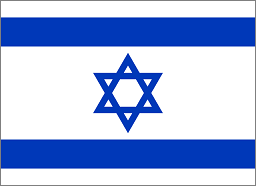 The Holocaust
had proven that the Jews would never be safe without
their own country. Lying low and assimilating hadn’t
saved them in Europe. They needed a homeland and an army
all their own. Unfortunately, there were no empty spots
on the map, but in 1897 Theodor Herzl had founded
the Zionist movement, named after the holy citadel of
Jerusalem, Mt. Zion. Zionism encouraged scattered Jews
to buy land and settle in Palestine, the sacred homeland
they had been expelled from almost two thousand years
earlier. Of course, a lot had changed since then.
For one thing, the Arab peoples who had replaced
the Jews had been there as long as anyone had been
anywhere, about as long as the Franks had been in France
and the Angles had been in England, so they would be
difficult to budge.
The Holocaust
had proven that the Jews would never be safe without
their own country. Lying low and assimilating hadn’t
saved them in Europe. They needed a homeland and an army
all their own. Unfortunately, there were no empty spots
on the map, but in 1897 Theodor Herzl had founded
the Zionist movement, named after the holy citadel of
Jerusalem, Mt. Zion. Zionism encouraged scattered Jews
to buy land and settle in Palestine, the sacred homeland
they had been expelled from almost two thousand years
earlier. Of course, a lot had changed since then.
For one thing, the Arab peoples who had replaced
the Jews had been there as long as anyone had been
anywhere, about as long as the Franks had been in France
and the Angles had been in England, so they would be
difficult to budge.
By the time Britain began releasing its Asian colonies in the late 1940s, Palestine had around 600,000 Jewish settlers who were insisting that they deserved their own country. In the 1917 Balfour Declaration, British authorities had impetuously promised a Jewish homeland, and the Zionists were going to hold them to it, by violence if necessary. When the British proved reluctant to follow through, an escalating campaign by Zionist terrorists killed hundreds, disrupted society and climaxed with the blowing up of dozens of British and Arabs, soldiers and civilians, at the King David Hotel in 1946. The British gave up soon after this and let the United Nations work out the details.
Out of the 1,900,000 people in Palestine, 68% were Arabs, and 32% were Jews. The UN plan was to carve up Palestine into three disjointed territories – one would be the Jewish state of Israel, one would be the Arab state of Palestine, and Jerusalem would be a free city under UN control. It wasn’t a fair split by any means. Any place with Jews was assigned to the Jewish state, while a region had to be almost pure Arab to get assigned to the Arab state. The result was a plan in which the Arabs made up 99% of the Arab State, but only 60% of Palestine’s Arabs lived there. Even grouping all the Jews together created a Jewish state that was 45% Arab.
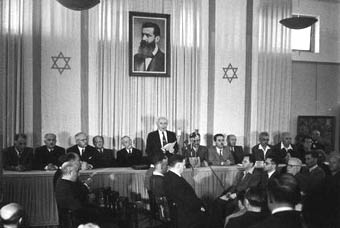 The
original plan fell apart right away. Jews and Arabs
began fighting even before the starting bell rang.
Terrorist attacks became guerrilla war until finally, on
May 15, 1948, the day of independence arrived, and they
could fight each other openly as sovereign nations.
The local Jews had been furiously training an army
for this day, smuggling armaments left over from World
War Two into British Palestine to equip it. Egypt,
Jordan and several other Arab countries attacked Israel
on behalf of the local Arabs. The Palestinian Arabs got
the worst of this first war, and 711,000 of them fled to
other countries, abandoning much of their designated
territory to be annexed by Israel. The only bits of Arab
Palestine that remained outside of Israeli control had
been seized by either the Egyptian (Gaza Strip) or
Jordanian (The West Bank) armies.
The
original plan fell apart right away. Jews and Arabs
began fighting even before the starting bell rang.
Terrorist attacks became guerrilla war until finally, on
May 15, 1948, the day of independence arrived, and they
could fight each other openly as sovereign nations.
The local Jews had been furiously training an army
for this day, smuggling armaments left over from World
War Two into British Palestine to equip it. Egypt,
Jordan and several other Arab countries attacked Israel
on behalf of the local Arabs. The Palestinian Arabs got
the worst of this first war, and 711,000 of them fled to
other countries, abandoning much of their designated
territory to be annexed by Israel. The only bits of Arab
Palestine that remained outside of Israeli control had
been seized by either the Egyptian (Gaza Strip) or
Jordanian (The West Bank) armies.
The party line in Israel for explaining this mass Arab exodus is that the Palestinians sullenly, spitefully and voluntarily abandoned their homes because they refused to live alongside Jews and they expected an imminent Arab victory to clear the way for their return - so everything that has happened to them since then is their own damn fault; however, historical research among eyewitnesses, archives and letters over the years has shown that this exodus happened mostly for the same reason every other war kicks up refugees: the people in the path of the armies had to get out of the way. They were afraid of starving, being caught in the crossfire or getting beaten, harassed or massacred, as happened to many of those who stayed behind. Regardless, all the Arabs who left homes in Israel to avoid the war lost their citizenship and their legal right to ever come back.
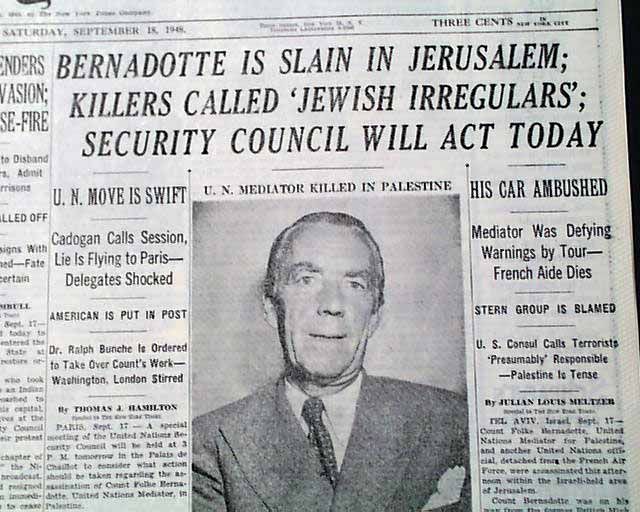 The
first attempt to negotiate a cease-fire failed in
September 1948 when Folke Bernadotte, the Swedish
diplomat sent by the United Nations to mediate a
settlement, was assassinated by Zionist agents who
didn’t like the plan he offered. His successor, the
American diplomat Ralph Bunche, began mediating in
January 1949, and by May he had convinced everyone to
stop shooting at each other.③
The
first attempt to negotiate a cease-fire failed in
September 1948 when Folke Bernadotte, the Swedish
diplomat sent by the United Nations to mediate a
settlement, was assassinated by Zionist agents who
didn’t like the plan he offered. His successor, the
American diplomat Ralph Bunche, began mediating in
January 1949, and by May he had convinced everyone to
stop shooting at each other.③
At the Lausanne Conference convened in April 1949 to work out a permanent solution, the Arab countries refused to even speak to the Israeli delegates, so representatives of the United Nations shuttled back and forth between them, carrying offers and counteroffers. The warring nations grudgingly agreed to accept the squiggly cease-fire line that cut through the middle of Palestine as the de facto international border, but no one was willing to agree that this was the final word on the subject. No one wanted to accept responsibility for the refugees. The Israeli government confiscated all the property they had left behind, and half-heartedly made - then withdrew - an offer to take back 100,000 (14%) of them. Neighboring countries did not want to absorb three-quarters of a million strangers, so they stashed the refugees in temporary camps until a better solution presented itself. Almost seventy years later, the refugees have bred up to 5 million, and everyone is still waiting for that solution.
![Map of Israel 1948-1999 [Map of Israel]](images/1948-Israel.gif) Thanks to the
exodus (regardless of the precise cause) Israel went
from being 45% Arab to a more manageable 20% Arab. The
remaining Arab citizens of Israel generally have the
same civil rights but fewer privileges than their Jewish
compatriots. They can, for example, vote, travel, access
the courts as easily as any other citizen, and work and
live anywhere they want. On the other hand, the Jewish
majority can usually impose specifically Jewish laws and
customs on the whole country. For the most part,
only Jews can legally immigrate to Israel from
elsewhere.④
Although Arabs can volunteer for the military if they
want, only Jews are trusted enough to be subjected to
universal conscription, which means that most Arabs
don’t acquire the skills, benefits packages, hiring
preferences and social networks that come with
compulsory military service. Recently, many of the most
blatantly discriminatory laws favoring Jews over Arabs
have been repealed, or at least rewritten to sound less
blatant.
Thanks to the
exodus (regardless of the precise cause) Israel went
from being 45% Arab to a more manageable 20% Arab. The
remaining Arab citizens of Israel generally have the
same civil rights but fewer privileges than their Jewish
compatriots. They can, for example, vote, travel, access
the courts as easily as any other citizen, and work and
live anywhere they want. On the other hand, the Jewish
majority can usually impose specifically Jewish laws and
customs on the whole country. For the most part,
only Jews can legally immigrate to Israel from
elsewhere.④
Although Arabs can volunteer for the military if they
want, only Jews are trusted enough to be subjected to
universal conscription, which means that most Arabs
don’t acquire the skills, benefits packages, hiring
preferences and social networks that come with
compulsory military service. Recently, many of the most
blatantly discriminatory laws favoring Jews over Arabs
have been repealed, or at least rewritten to sound less
blatant.
To keep anyone else from doing to the Israelis what the Israelis had done to the Palestinians, Israel now has very strict laws against selling land to foreigners. In fact, by law, almost all land in Israel is held by the government and can only be leased, never sold, so the possession of property depends mostly on political connections. The Israeli agencies in charge of reallocating all the land abandoned by the Arabs in 1948 have always given preference to Jewish settlement.
For the most part, the Arabs of Palestine and the surrounding nations did not accept that Israel even had a right to exist. To them, the Zionists were alien intruders brought in by former colonial imperialists to stake out a permanent foothold of Western civilization. The Arabs considered this unacceptable and were not about to let the Israelis stay. Ironically, that’s also how a lot of Westerners have viewed Israel over years, except they consider being a foothold of Western civilization to be a good thing. Anyway, toward the end of May 1967, Israel spotted its Arab neighbors getting ready to attack again and push them into the sea, so Israel struck first. Over the course of a week in June, Israel knocked out the threatening armies and expanded along all fronts. This brought the whole of Palestine under Israeli control. It also put huge numbers of Palestinian Arabs back in Israeli hands.
If this book were a history of international relations in the 20th Century, there would be much more to say, but since we’re dealing with the history of democracy, the main question becomes “Is Israel a democracy?” The answer is “Yes” - with a big asterisk.
The asterisk is there because the nation is perfectly democratic for the 5.6 million Jewish citizens of Israel, mostly democratic for the 1.4 million Arab citizens of Israel and entirely oppressive for the 4.2 million Palestinians in the Occupied Territories. We’ll pick up the story again in the 1990s.Ⓑ
South Africa
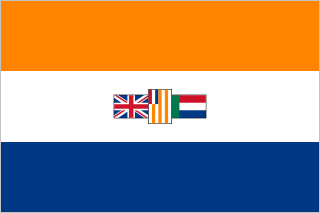 The Union
of South Africa was assembled in 1910 from the four
neighboring colonies
that, one by one, had been founded by Dutch settlers
and then conquered by the British. Each had its
own semi-democratic political heritage. The motherlands,
Holland and England, had been among the most liberal in
the world at the time, and the settlers were foursquare
in favor of democratic governing, at least when applied
to themselves. For natives and immigrants of a darker
hue, not so much. For the first few decades of its
existence, while the World Wars raged, politics in South
Africa focused on the question of how closely they
wanted to be tied to Britain – Anglo-Saxon settlers in
favor of more, Dutch settlers in favor of less.
The Union
of South Africa was assembled in 1910 from the four
neighboring colonies
that, one by one, had been founded by Dutch settlers
and then conquered by the British. Each had its
own semi-democratic political heritage. The motherlands,
Holland and England, had been among the most liberal in
the world at the time, and the settlers were foursquare
in favor of democratic governing, at least when applied
to themselves. For natives and immigrants of a darker
hue, not so much. For the first few decades of its
existence, while the World Wars raged, politics in South
Africa focused on the question of how closely they
wanted to be tied to Britain – Anglo-Saxon settlers in
favor of more, Dutch settlers in favor of less.
Most British colonies had a color bar that kept natives subordinate and far away from the whites; South Africa was no different. Native tribes living in the boondocks were treated as autonomous enclaves. At first, most blacks stayed in their own rural villages with minimal interference (at least until the whites found a valuable natural resource nearby or needed to round up some cheap, expendable labor), but when blacks moved away from their villages and tried to live among whites, they found barriers and exploitation everywhere they went. As more natives went to live and work in cities, ranches, farms and mines, this became a problem. The oppression was intensified by the Native Lands Act of 1913, in which blacks were effectively forbidden from owning any land that the whites might want. This put 90% of the country off-limits.
![A flier used by the National Party to win the 1948 election in South Africa [1948 National Party flier]](images/1948_flier-used-by-the-national-party-to-win-election-.jpg) As
racial discrimination grew less fashionable elsewhere in
the British Commonwealth, South Africa was pressured to
change, but they veered off in the opposite direction
instead. In 1948 the white supremacist National Party
was elected to run South Africa. They set out to
completely eliminate the few civil rights enjoyed by the
nonwhite population with a policy called
apartheid (“aparthood”) which would subordinate
nonwhites to whites in every aspect of life in South
Africa.
As
racial discrimination grew less fashionable elsewhere in
the British Commonwealth, South Africa was pressured to
change, but they veered off in the opposite direction
instead. In 1948 the white supremacist National Party
was elected to run South Africa. They set out to
completely eliminate the few civil rights enjoyed by the
nonwhite population with a policy called
apartheid (“aparthood”) which would subordinate
nonwhites to whites in every aspect of life in South
Africa.
Voting rights in the three newer colonies (Natal, Orange and Transvaal) were already restricted by race, not property or literacy. All white men (but only white men) had a voice in government. In older Cape Province the opposite rules were in place. The Dutch had settled Cape Town in 1652, and during the subsequent centuries, the local natives had been completely disrupted, jumbled and mixed. By the twentieth century, the Cape Coloureds of mixed race constituted the single largest race in the province -- not a majority, but outnumbering the pure-blooded descendants of any other race. Most had been born into Western ways which they inherited from white ancestors.
In Cape Province, class not race mattered. Voting rights depended on property and literacy, which meant that in Cape Town poor whites were disenfranchised, but middle class, educated Coloured men had the vote. Granted, no Coloured man had ever been elected to office, but they accounted for around 15% of eligible voters in Cape Province and exerted an influence. Obviously, as South Africa became more racist, this had to stop. In 1931, voting rights were extended to all whites, male and female, rich and poor; however nothing changed for nonwhites except that their voting strength relative to the white votes crashed. In 1951, the remaining nonwhites still qualified to vote were kept from participating in the general election and instead given a handful of separate parliamentary seats to fight over. Those seats were eventually abolished in 1968.
Removing the Cape Coloureds from politics also tightened the National Party’s grip on power at the expense of the more centrist United Party. The relatively liberal freedoms of speech, assembly and the press that South Africa had enjoyed until now were restricted so that the system could never be challenged. Most dissent was reclassified as inciting terrorism and outlawed.
To justify keeping voting rights out of the hands of the black majority, South Africa now created imaginary little countries for their major native ethnic groups. Most blacks were then assigned citizenship of these allegedly independent tribal homelands, which meant that South Africa could treat these people as resident aliens, with no political rights, no labor rights, no property rights, and the threat of deportation to some desolate wasteland hanging over them all the time. While all the cities, resources, transport lines and good farmland remained in South African hands, the native Bantustans were scattered all over the map in lands that no one else wanted.
In the end, however, even this elaborate ruse failed to keep the world from picking on them. South Africa became increasingly isolated.⑤
-- Matthew White

![[Previous Chapter]](images/previous_arrow.gif) |
![[Next Chapter]](images/next_arrow.gif) |
① Technically, as a League of Nations mandate rather than a colony. The main difference was that mandates were explicitly supposed to get their independence eventually.
② Polity IV score: 8. Also, woman had been given the vote in 1953.
③ As an African-American, Ralph Bunche became the first non-white winner of the Nobel Peace Prize for this. It was the first of four Nobel Prizes awarded over the years for bringing peace to Israel – and the way things are going, there will always be plenty of opportunities to win more peace prizes in this part of the world. Also, Yitzhak Shamir, one of the leaders of the conspiracy that assassinated Bernadotte, would later serve two terms as prime minister of Israel, 1983–84 and 1986–92.
④ Many of the Jews arriving in Israel shortly following independence came from Jewish communities persecuted in Arab countries in retaliation for the ongoing Arab-Israeli conflict. The phrase “two wrongs don’t make a right” comes to mind.
⑤ One peculiarity of South African government unrelated to civil rights is that it never picked one city to be the nation’s capital. Instead, the various branches of government are distributed among the capital cities of the original provinces. Pretoria, former capital of Transvaal, houses the executive branch. Cape Town has the legislature, and Bloemfontein, former capital of the Orange Free State, has the judiciary.
Ⓐ Sami M. Moubayed, Steel & Silk: Men and Women who Shaped Syria 1900-2000 (Cune Press, 2006) pp.308-314
Ⓑ David Schafer, “Triumph and Catastrophe”, The Humanist, Nov/Dec. 2002.
Copyright © June 2020 by Matthew White
